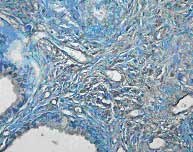PC461
PhosphoDetect Anti-p53 (pSer¹⁵) (Ab-6) Rabbit pAb
liquid, Calbiochem®, from rabbit
biological source
rabbit
Quality Level
antibody product type
primary antibodies
form
liquid
does not contain
preservative
species reactivity
human
manufacturer/tradename
Calbiochem®
storage condition
OK to freeze
avoid repeated freeze/thaw cycles
isotype
IgG
shipped in
wet ice
storage temp.
−20°C
General description
Rabbit polyclonal antibody supplied as undiluted serum. Recognizes the ~53 kDa p53 phoshorylated at Ser15.
This PhosphoDetect Anti-p53 (pSer¹⁵) (Ab-6) Rabbit pAb is validated for use in Immunoblotting, Paraffin Sections for the detection of p53 (pSer¹⁵) (Ab-6).
This product has been discontinued.
Recognizes the ~53 kDa p53 protein phosphorylated at Ser15. Does not recognizes unphosphorylated p53.
Recognizes the ~53 kDa p53 protein phosphorylated at Ser15. Does not recognizes unphosphorylated p53.
Immunogen
Human
a synthetic phosphopeptide [VEPPLpSQETFS(C)] corresponding to amino acids 10-20 surrounding the Ser¹⁵ phosphorylation site of human p53
Application

Immunoblotting (1:5000-1:10,000)
Paraffin Sections (1:1000-1:3000, heat pre-treatment required)
Physical form
Undiluted serum.
Preparation Note
Following initial thaw, aliquot and freeze (-20°C).
Analysis Note
Positive Control
MCF7 cells or prostate carcinoma tissue
MCF7 cells or prostate carcinoma tissue
Other Notes
Does not recognizes unphosphorylated p53. Antibody should be titrated for optimal results in individual systems.
Levine, A.J. 1997. Cell88, 323.
Meek, D.W. 1997. Pathol. Biol. Paris45, 804.
Miller, S.D., et al. 1997. Mol. Cell. Biol.17, 2194.
Pellegata, N.S., et al. 1996. Proc. Natl. Acad. Sci. USA93, 15209.
Sturzbecher, H.-W., et al. 1996. EMBO J.15, 1992.
Argarwal, M.L., et al. 1995. Proc. Natl. Acad. Sci. USA92, 8493.
Götz, C. and Montenarh, M. 1995. Int. J. Oncology6, 1129.
Reed, M. et al. 1995. Proc. Natl. Acad. Sci. USA92, 9455.
Waldman, T., et al. 1995. Cancer Res.55, 5187.
Cho, Y., et al. 1994. Science265, 346.
Clarke, A.R., et al. 1994. Oncogene9, 1767.
El-Deiry, W.S., et al. 1994. Cancer Res.54, 1169.
Greenblatt, M.S., et al. 1994. Cancer Res.54, 4855.
Lane, D.P. 1992. Nature358, 15.
Meek, D.W. 1997. Pathol. Biol. Paris45, 804.
Miller, S.D., et al. 1997. Mol. Cell. Biol.17, 2194.
Pellegata, N.S., et al. 1996. Proc. Natl. Acad. Sci. USA93, 15209.
Sturzbecher, H.-W., et al. 1996. EMBO J.15, 1992.
Argarwal, M.L., et al. 1995. Proc. Natl. Acad. Sci. USA92, 8493.
Götz, C. and Montenarh, M. 1995. Int. J. Oncology6, 1129.
Reed, M. et al. 1995. Proc. Natl. Acad. Sci. USA92, 9455.
Waldman, T., et al. 1995. Cancer Res.55, 5187.
Cho, Y., et al. 1994. Science265, 346.
Clarke, A.R., et al. 1994. Oncogene9, 1767.
El-Deiry, W.S., et al. 1994. Cancer Res.54, 1169.
Greenblatt, M.S., et al. 1994. Cancer Res.54, 4855.
Lane, D.P. 1992. Nature358, 15.
Legal Information
CALBIOCHEM is a registered trademark of Merck KGaA, Darmstadt, Germany
Disclaimer
Toxicity: Standard Handling (A)
Not finding the right product?
Try our Product Selector Tool.
Storage Class Code
10-13 - German Storage Class 10 to 13
Regulatory Information
新产品
This item has
Certificates of Analysis (COA)
Search for Certificates of Analysis (COA) by entering the products Lot/Batch Number. Lot and Batch Numbers can be found on a product’s label following the words ‘Lot’ or ‘Batch’.
Already Own This Product?
Find documentation for the products that you have recently purchased in the Document Library.
Rajashree A Deshpande et al.
Nucleic acids research, 45(9), 5255-5268 (2017-04-04)
The Mre11-Rad50-Nbs1(Xrs2) (MRN/X) complex is critical for the repair and signaling of DNA double strand breaks. The catalytic core of MRN/X comprised of the Mre11 nuclease and Rad50 adenosine triphosphatase (ATPase) active sites dimerizes through association between the Rad50 ATPase
Cai Bowen et al.
Cell reports, 4(3), 516-529 (2013-07-31)
The prostate tumor suppressor NKX3.1 augments response to DNA damage and enhances survival after DNA damage. Within minutes of DNA damage, NKX3.1 undergoes phosphorylation at tyrosine 222, which is required for a functional interaction with ataxia telangiectasia mutated (ATM) kinase.
Zhi Guo et al.
Cell cycle (Georgetown, Tex.), 9(24), 4805-4811 (2010-12-15)
The Ataxia-Telangiectasia mutated (ATM) kinase is regarded as the major regulator of the cellular response to DNA double strand breaks (DSBs). In response to DSBs, ATM dimers dissociate into active monomers in a process promoted by the Mre11-Rad50-Nbs1 (MRN) complex.
Gary G Chiang et al.
Methods in molecular biology (Clifton, N.J.), 281, 125-141 (2004-06-29)
Members of the phosphoinositide-3-kinase-related kinase (PIKK) family, which includes mTOR, ATM, ATR, and hSMG-1, play important roles in regulating the cellular response to environmental stimuli. Despite the similarity of their catalytic domain to that of phosphoinositide-3-kinase, these extremely large (>250
Ji-Hoon Lee et al.
The Journal of biological chemistry, 288(18), 12840-12851 (2013-03-26)
The Ataxia Telangiectasia-Mutated (ATM) protein kinase is recruited to sites of double-strand DNA breaks by the Mre11/Rad50/Nbs1 (MRN) complex, which also facilitates ATM monomerization and activation. MRN exists in at least two distinct conformational states, dependent on ATP binding and
Our team of scientists has experience in all areas of research including Life Science, Material Science, Chemical Synthesis, Chromatography, Analytical and many others.
Contact Technical Service